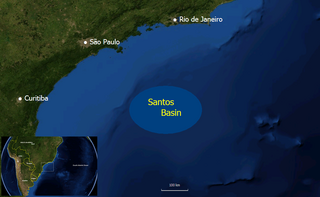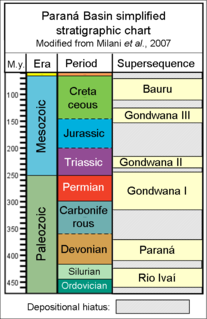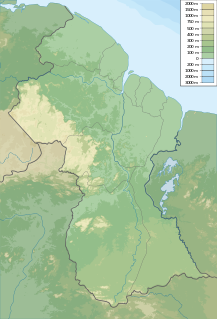 W
WThe Açu Formation is an Early Cretaceous (Albian) geologic formation of the Potiguar Basin in Ceará, northeastern Brazil. The formation comprises coarse-grained sandstones deposited in a fluvio-deltaic environment. The Açu Formation, belonging to the Apodi Group, has provided fossils of an indeterminate rebbachisaurid.
 W
WThe Adamantina Formation is a geological formation in the Bauru Basin of western São Paulo state, in southeastern Brazil.
 W
WThe Alcântara Formation is a geological formation in northeastern Brazil whose strata date back to the Cenomanian of the Late Cretaceous.
 W
WThe Antenor Navarro Formation is an Early Cretaceous geologic formation in Brazil. Fossil sauropod tracks have been reported from the formation.
 W
WThe Areado Group is a Late Jurassic to Early Cretaceous geologic group in southeastern Brazil. The group was defined by Cardoso in 1968.
 W
WThe Bahia Group, also known as Bahia Series, is an Aptian geologic group of the Recôncavo Basin in Bahia, Brazil. Dinosaur remains are among the fossils that have been recovered from the formation, although none have yet been referred to a specific genus. The conglomerates were deposited in an estuarine environment.
 W
WThe Bauru Group is a geological group of the Bauru Sub-basin, Paraná Basin in Minas Gerais, São Paulo, General Salgado, Itapecuru-Mirim, Mato Grosso, Brazil whose strata date back to the Late Cretaceous. Dinosaur remains are among the fossils that have been recovered from the formation.
 W
WThe Botucatu Formation is an Aptian geologic formation of the Paraná and Pelotas Basins in southern Brazil and northern Uruguay. The formation is composed of quartzitic sandstones, deposited in an eolian environment. Fossil theropod tracks have been reported from the formation.
 W
WThe Caiuá Formation is an Early Cretaceous geologic formation in Brazil and Paraguay. Fossil theropod tracks have been reported from the formation. The formation, the lowermost unit of the Bauru Group, was deposited in the Barremian and Aptian epochs of the Early Cretaceous, around 130 to 120 Ma. The formation is unconformably overlain by the Santo Anastácio Formation and the unconformity probably represents the start of the opening of the South Atlantic and the formation of the Santos Basin.
 W
WThe Candelária Formation, in other literature also referred to as Candelária Sequence, is a sedimentary formation of the Santa Maria Group in the Paraná Basin in Rio Grande do Sul, southeastern Brazil. The formation dates to the Carnian of the Late Triassic, locally referred to as Tuvalian, from 231.4 to approximately 222 Ma.
 W
WThe Caturrita Formation is a rock formation found in Rio Grande do Sul, Brazil. Its sediments were deposited in the Paraná Basin. The formation is from the Upper Triassic and forms part of the Santa Maria Supersequence in the upper section of the Rosário do Sul Group.
 W
WThe Corda Formation is a red sandstone geologic formation in the Parnaíba Basin in Tocantins, Brazil. It was formed during the Neoaptian to Eoalbian series of the Early Cretaceous.
 W
WThe Crato Formation is a geologic formation of Early Cretaceous (Aptian) age in northeastern Brazil's Araripe Basin. It is an important Lagerstätte for palaeontologists. The strata were laid down mostly during the early Aptian age, about 113 million years ago, in a shallow inland sea. At that time, the South Atlantic was opening up in a long narrow shallow sea.
 W
WThe Exu Formation is an Albian geologic formation in Brazil. Pterosaur fossils of Lophocratia indet. have been recovered from the formation.
 W
WThe Florianópolis Formation is a geological formation of the Santos Basin offshore of the Brazilian states of Rio de Janeiro, São Paulo, Paraná and Santa Catarina. The predominantly sandstone formation with interbedded shales and siltstones dates to the Early Cretaceous period; Albian epoch and has a thickness in the type oil well of 343 metres (1,125 ft).
 W
WThe Goio-Erê Formation is a geological formation in Brasil, it was deposited between the Turonian and Campanian stages of the Late Cretaceous. It primarily consists of sandstone and was deposited in a desert environment. It is known for its exceptional 3-D preservation of fossils, which include those of the pterosaurs Keresdrakon and Caiuajara as well as the lizard Gueragama.. It is laterally equivalent to the Rio Paraná Formation
 W
WThe Guabirotuba Formation is a late Middle Eocene geologic formation of the Curitiba Basin in Paraná, Brazil. The formation crops out in and around the city of Curitiba and comprises mudstones and sandstones deposited in a fluvial floodplain environment.
 W
WThe Guaratiba Group is a geological group of the Santos Basin offshore of the Brazilian states of Rio de Janeiro, São Paulo, Paraná and Santa Catarina. The group forms the pre-salt layer in the petroleum-rich basin and hosts the biggest oil fields of Brazil, as Tupi, Júpiter and many more. The group contains, depending on the definition, three to four formations and dates to the Early Cretaceous period; Hauterivian to Early Aptian epochs. The total thickness of the group, representing the first phase of sedimentation after the break-up of Gondwana in the Santos Basin, is estimated at 4,200 metres (13,800 ft).
 W
WThe Guarujá Formation is a geological formation of the Santos Basin offshore of the Brazilian states of Rio de Janeiro, São Paulo, Paraná and Santa Catarina. The predominantly calcarenite formation with marls dates to the Early Cretaceous period; Early Albian epoch and has a maximum thickness of 2,500 metres (8,200 ft). The formation is the second-most important post-salt reservoir rock of the Santos Basin.
 W
WThe Iguape Formation is a geological formation of the Santos Basin offshore of the Brazilian states of Rio de Janeiro, São Paulo, Paraná and Santa Catarina. The calcarenite, shale, siltstone, marl and conglomerate formation dates to the Tertiary period and has a maximum thickness of 2,200 metres (7,200 ft).
 W
WThe Ipubi Formation is the middle geological formation of the Santana Group, the middle part of the Araripe Group, in the Araripe Basin of northeastern Brazil. The formation is dated to the Aptian to Albian stages of the Early Cretaceous, unconformably overlying the Crato Formation and unconformably overlain by the Romualdo Formation, formerly known as the Romualdo Member of the Santana Formation. The averaging 15 metres (49 ft) thick Ipubi Formation comprises shales and sandstones in the lower section and evaporites in the upper part of the formation, deposited in a transgressive to highstand lacustrine environment in the Araripe rift basin.
 W
WIrati Formation is the name of a geological formation of the Paraná Basin in Brazil. It has previously been dated as Late Permian using palynomorphs, but is now dated as Early Permian using zircon ages obtained from bentonite layers. The base of the formation has been dated at 278.4 ± 2.2 Ma. Exposures of the Irati Formation are to be found in the South, southeastern Brazil and in the states of Goiás, Mato Grosso, São Paulo, Paraná, Santa Catarina, Rio Grande do Sul and Mato Grosso do Sul. The formation is part of the Passa Dios Group, underlying the Serra Alta Formation and overlying the Palermo Formation. The formation has been deposited in a restricted marine environment. The Irati Formation, with a maximum thickness of 80 metres (260 ft), was defined and named by White in 1908.
 W
WThe Itaboraí Formation is a highly fossiliferous geologic formation and Lagerstätte of the Itaboraí Basin in Rio de Janeiro, southeastern Brazil. The formation reaching a thickness of 100 metres (330 ft) is the defining unit for the Itaboraian South American land mammal age (SALMA), dating to the Early Eocene, approximately 53 to 50 Ma.
 W
WThe Itajaí-Açu Formation is a geological formation of the Santos Basin offshore of the Brazilian states of Rio de Janeiro, São Paulo, Paraná and Santa Catarina. The predominantly shale with interbedded turbiditic sandstones formation dates to the Late Cretaceous period; Cenomanian-Maastrichtian epochs and has a maximum thickness of 2,000 metres (6,600 ft). The formation is a reservoir rock of the fields in the Santos Basin.
 W
WThe Itanhaém Formation is a geological formation of the Santos Basin offshore of the Brazilian states of Rio de Janeiro, São Paulo, Paraná and Santa Catarina. The predominantly shale formation with marls, siltstones and sandstones dates to the Early Cretaceous period; Early Albian epoch and has a maximum thickness of 1,500 metres (4,900 ft). The formation is the reservoir rock of the Tambaú Field in the Santos Basin.
 W
WThe Itapecuru Formation is a geological formation in Itapecuru Mirim, Maranhão, Brazil.
 W
WThe Juréia Formation is a geological formation of the Santos Basin offshore of the Brazilian states of Rio de Janeiro, São Paulo, Paraná and Santa Catarina. The predominantly shale with interbedded siltstones and fine sandstones formation dates to the Late Cretaceous period; Santonian-Maastrichtian epochs and has a maximum thickness of 2,000 metres (6,600 ft). The formation is a reservoir rock of the Merluza Field, the first discovery in the Santos Basin.
 W
WThe Malhada Vermelha Formation is an Early Cretaceous geologic formation in Ceará, northeastern Brazil. The formation preserves reptile, fish and ichnofossils.
 W
WThe Marambaia Formation is a geological formation of the Santos Basin offshore of the Brazilian states of Rio de Janeiro, São Paulo, Paraná and Santa Catarina. The predominantly shale and marl formation dates to the Tertiary period and has a maximum thickness of 2,700 metres (8,900 ft). The formation is a seal and reservoir rock of the Atlanta and Oliva Fields in the Santos Basin.
 W
WThe Maria Farinha Formation is a geological formation of the Parnaíba Basin in Pernambuco, northeastern Brazil whose strata date back to the Danian stage of the Paleocene, or Tiupampan in the SALMA classification.
 W
WThe Marília Formation is a geological formation in Goiás, Minas Gerais, and São Paulo states of southeastern Brazil. Its strata date back to the Maastrichtian, and are part of the Bauru Group.
 W
WThe Missão Velha Formation is an early Aptian geologic formation in northeastern Brazil's Araripe Basin where the states of Pernambuco, Piauí and Ceará come together. The formation is the middle stratigraphic unit of the Vale do Carirí Group, overlying the Brejo Santo Formation and overlain by the Abaiara Formation.
 W
WThe Pastos Bons Formation is a Late Jurassic geologic formation of the Parnaíba Basin in Maranhão, northeastern Brazil. The formation forms part of the sag phase of the basin. It overlies the Sardinha Formation and is overlain by the Mosquito Formation. The fluvial to lacustrine sandstones and shales have provided fossils of a coelacanth fish, Parnaibaia maranhaoensis and a paralligatorid named after the formation, Batrachomimus pastosbonensis.
 W
WThe Presidente Prudente Formation is a geological formation of the Bauru Group in the Paraná Basin, located in Brazil whose strata date back to the Late Campanian to Early Maastrichtian.
 W
WThe Quiricó Formation is a geological formation of the Areado Group in Minas Gerais, Brazil whose strata date back to the Lower Cretaceous. Many occurrences of fossils are reported in the lacustrine deposits of the Quiricó Formation.
 W
WThe Rio Bonito Formation is a geological formation of the Paraná and Pelotas Basins of Permian age. It is represented by a succession of cyclic sedimentary packages of sandstones, siltstones and shales which bear extensive deposits of coal that has been extracted since the 19th century. The Rio Bonito Formation was deposited in a coastal environment, formed by rivers, deltas, bays and estuaries with tidal plains, barrier islands and shallow marine platform, at a time when the Paraná Basin was a large gulf of the ancient supercontinent Gondwana. This gulf was open to the southwest, to the old ocean Panthalassa. The Rio Bonito Formation outcrops occur mainly in the eastern border of the Paraná Basin, in a narrow band in the states of São Paulo, Paraná, Santa Catarina, Rio Grande do Sul and Uruguay. The Rio Bonito Formation belongs to the second-order stratigraphic supersequence called Gondwana I.
 W
WThe Rio do Rasto Formation is a Late Permian sedimentary geological formation in the South Region of Brazil. The official name is Rio do Rasto, although in some publications it appears as Rio do Rastro.
 W
WThe Rio Piranhas Formation is a Berriasian to Hauterivian geologic formation in Paraíba, Brazil. Fossil ornithopod tracks have been reported from the formation. Also fossils of Triunfosaurus leonardii have been found in the formation.
 W
WThe Romualdo Formation is a geologic Konservat-Lagerstätte in northeastern Brazil's Araripe Basin where the states of Pernambuco, Piauí and Ceará come together. The geological formation, previously designated as the Romualdo Member of the Santana Formation, named after the village of Santana do Cariri, lies at the base of the Araripe Plateau. It was discovered by Johann Baptist von Spix in 1819. The strata were deposited during the Albian stage of the Early Cretaceous in a lacustrine rift basin with shallow marine incursions of the proto-Atlantic. At that time, the South Atlantic was opening up in a long narrow shallow sea.
 W
WThe Sanga do Cabral Formation is a sedimentary rock formation found in Rio Grande do Sul, Brazil.
 W
WThe Santana Group is a geologic group, formerly included as the middle part of the Araripe Group, in the Araripe Basin of northeastern Brazil. The group comprises the Crato, Ipubi and Romualdo Formations and is dated to the Aptian to Albian stages of the Early Cretaceous. The formations of the group were deposited in a lacustrine to subtidal shallow marine environment in the Araripe rift basin.
 W
WThe Santos Formation is a geological formation of the Santos Basin offshore of the Brazilian states of Rio de Janeiro, São Paulo, Paraná and Santa Catarina. The predominantly conglomeratic sandstone formation with interbedded shales dates to the Late Cretaceous period; Cenomanian-Maastrichtian epochs and has a maximum thickness of 2,700 metres (8,900 ft).
 W
WThe Sepetiba Formation is a geological formation of the Santos Basin offshore of the Brazilian states of Rio de Janeiro, São Paulo, Paraná and Santa Catarina. The predominantly coquina formation dates to the Pleistocene period to recent and has a variable but maximum thickness of 570 metres (1,870 ft). The formation is the uppermost unit of the Santos Basin.
 W
WThe Sousa Formation is a Berriasian-Hauterivian geologic formation in Paraíba, Brazil. Fossil sauropod tracks have been reported from the formation.
 W
WThe Sucunduri Formation is a Neoproterozoic geologic formation in Brazil. While reports made in the 1950s state that dinosaur remains were among the fossils that have been recovered from the formation, none of which referred to a specific genus, later research has questioned this interpretation. The formation crops out in Amazonas.
 W
WThe Takutu Formation is a Late Jurassic geologic formation in Guyana and northern Brazil. The formation comprises sandstones deposited in a shallow water to littoral setting. Fossil theropod tracks have been reported from the formation. A paleobotanic analysis of drill cores of the formation was conducted by Thomas van der Hammen in 1966 and showed fossil Classiopolis flora.
 W
WThe Uberaba Formation is a Campanian geologic formation belonging to the Bauru Group of the Bauru Sub-basin, Paraná Basin located in Minas Gerais state of southeastern Brazil. The Uberaba Formation, intercalating the fossiliferous older Adamantina and younger Marília Formation, comprises limestones, sandstones, and conglomerates, often cemented by calcite with volcaniclastic sediments. The formation interfingers with the Adamantina Formation.